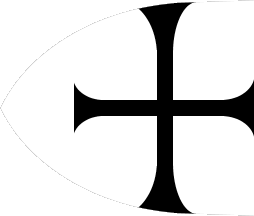![[Flag of Dongola]](../images/s/sd-do14f.gif) Image by António Martins-Tuválkin, 05 Dec 2007
Image by António Martins-Tuválkin, 05 Dec 2007
Last modified: 2015-05-24 by bruce berry
Keywords: sudan | book of all kingdoms | graciona | dongola | abdeselib |
Links: FOTW homepage |
search |
disclaimer and copyright |
write us |
mirrors
See also:
![[Flag of Dongola]](../images/s/sd-do14f.gif) Image by António Martins-Tuválkin, 05 Dec 2007
Image by António Martins-Tuválkin, 05 Dec 2007
The 74th flag mentioned and illustrated in the
Book of All Kingdoms is attributed
to Dongola, a state near the current Sudan, said
to be founded and peopled by Nubians.
This as depicted in the
2005 Spanish illustrated transcription, a white flag with a black cross patty with two horizontal bars, and the
vertical bar throughout, the flag in the ogival default shape of this
source.
The anonymous author of
Book of All Kingdoms describes the
flag thus: "E el rey d’ella á por se&ntilda;ales un pendón blanco con una cruz fecha así." (
meaning "The King
of Dongola has for his device a white flag with a cross like this", as translated in the Halkyut Society edition.)
António Martins-Tuválkin, 05 Dec 2007
Dongola was the capital of the
Christian Nubian kingdom of Makuria, and was often used as the name of
the whole kingdom. The core of the kingdom lay between the 3rd and
5th cataracts in the Nile valley of northern Sudan. See
http://en.wikipedia.org/wiki/Muqurra ,
http://en.wikipedia.org/wiki/History_of_Sudan#Christian_Nubia
and http://en.wikipedia.org/wiki/Old_Dongola for more info on Makuria and Dongola.
Ned Smith, 05 Dec 2007
 Image by Eugene Ipavec, 07 Dec 2007
Image by Eugene Ipavec, 07 Dec 2007
The 78th flag mentioned and illustrated in the
Book of All Kingdoms is attributed
to Graciona / Granciona, the capital of Empiror
Abdeselib, supposedly located somewhere in the current Sudan.
This as depicted in the
2005 Spanish illustrated transcription, this is a white flag with a black cross patty throughout (actually,
stretched to
top, bottom and hoist, but not extending to the fly tip), the flag in the
oval default shape of this source.
According to the Halkyut Society edition (#70 on plate
15 between p.34-35), the manuscript "S" (the [f0fXXs]) shows this flag.
The anonymous author of
Book of All Kingdoms describes the
flag thus: "E este emperador Abdeselib á por senales un pendón de plata con una cruz prieta
d'esta manera." (meaning "The Emperor Abdeselib has for his device a white flag
with a black cross like this", as translated in the Halkyut Society edition.)
António Martins-Tuválkin, 06 Dec 2007
![[Flag of Tremecin]](../images/s/sn_n14f.gif) image by Eugene Ipavec, 6 December 2007
image by Eugene Ipavec, 6 December 2007
The 73rd flag mentioned and illustrated in the
Book of All Kingdoms is attributed
to Tremecin, an oasis state probably somewhere in current Mali or Niger. This
is, as depicted in the 2005 Spanish illustrated transcription,
a grey (standing for purple) flag with a
white crescent (with visible black lining) facing the hoist, the flag in the ogival default shape of this source. The anonymous author of
Book of All Kingdoms describes the flag
thus: "E el rey d’este reinado á por señales un pendón cárdeno con una luna
blanca atal." ("The King has for his device a purple flag with a white moon", as
translated in the Halkyut edition.)
António Martins-Tuválkin, 4 December 2007
According to the "Book", this state might be somewhere in present-day Sudan:
"Partí de Tauser e andude muy gran camino por la Zaara en camellos, e llegué a
otro reinado que dizen Tremisin, e confina con el flumen Nilus e siempre bive en
guerra con los cristianos de Nubia e de Etiopía."
The same source claims
that the original inhabitants of the city of Tlemcen, Algeria had arrived from
this area:
"E sabet que las gentes d'este reinado poblaron a Tremecen la de
Berbería."
For this reason, the state and its capital, whose name is
spelled Trimisin in the "Book", might both be also called Tlemcen.
The
portolanos indeed often show a blue (sometimes black) flag charged with a white
crescent, in the area bordered with the Nile to the east and the Blue Nile to
the south (if we accept that the two rivers shown to form the Nile on the maps
are indeed meant to be the Blue Nile and the White Nile). A gallery of the
portolanos is found at the Histocat website:
http://www.histocat.cat/index.html?msgOrigen=7&Familia=FA008&Subfamilia=SF061
Most of these show the flag above a city named simply Nubia, but map of
Gabriel Vallseca, created on Majorca in 1439 and nowadays kept at Naval Museum,
Barcelona, explicitly names the city "Tirimse de Nubia", i.e. "Tlemcen of Nubia":
http://www.histocat.cat/index.html?msgOrigen=6&CODART=ART00166
(Image:
http://www.histocat.cat/resource/)
Enlarged detail of the map is shown
here:
http://www.hubert-herald.nl/SudanI.htm#MN1323 (Image:
http://www.hubert-herald.nl/SudanI_bestanden/image016.jpg) and the flag is
blue with a white crescent.
For a discussion on how purple from the
"Book" was changed to blue on most of the portolanos, see
here.
Tomislav Todorovic,
22 October 2012